When we think about the building blocks of a new human society, a human society that doesn’t destroy the planetary biosphere, that nurtures and supports human beings and communities, that fosters our creativity and innovation—I think it starts in fostering healthy, skilled communities of people who live in honor and reverence with the land. This involves reskilling–the process of building our basic skills for life in a range of disciplines connected with traditional food and lifeways (canning, growing or foraging food, food preservation, herbalism, weaving, carving, and so forth) and also fostering strong communities surrounding those skills. Of course, all of these traditions are also steeped in their own magic and lore, from the magic of spinning and dyeing to bread baking and herbalism, which helps reenchant the world. I spoke at length about reskilling in my book Sacred Actions: Living the Wheel of the Year through Earth-Centered Sustainable Practices for just this reason: by embracing traditional skills that help provide our basic needs and support our communities, we learn how to work with the nature right outside our door which allows us to be good stewards of the land and connect in a reciprocal way to all of the world around us.
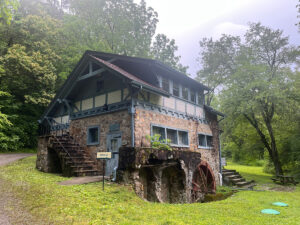
A beautiful example of this can be found in the folk school tradition, where schools are established to teach these basic traditional skills in non-competitive, joyful ways that nurture individuals and foster a strong community. I was blessed with the chance to spend this past week at the John C. Campbell Folk School to take a master class in Full Case Leather Bookbinding in the Smokey Mountains in North Carolina. John C. Campbell Folk School was the first folk school here in the US and was modeled after the Danish Folk School tradition. Thus, it remains one of the largest and most well-established here in North America, with upwards of 20 classes or more taking place year-round in a wide variety of disciplines (you can check out their full catalog here). More than the classes, though, visiting the Folk School was a welcome opportunity to immerse myself in a range of community-supported traditions, traditional folkways, music, and culture. Today, I want to spend time talking both about folk traditions, culture, and folkways as well as providing an overview of this beautiful model and some broader takeaways.
Folk Traditions and Folkways

The idea of “folk” is an important one here to explore: the concept of “Folk culture” is typically used for small groups of usually homogeneous people living in rural or remote locations that develop their own cultural practices, creative practices (art, song, dance), foodways, rituals and traditions, and ways of inhabiting tied to local ecosystems. Folk practices are still found in many parts of the world, but just like everything else, are threatened by globalization which seeks to homogenize everything with consumer culture. They are also threatened with materialism, replacing local, unique culture with–at least here in the US–McDonald’s, Home Depot, Walmart for purchasing goods and local entertainment and crafts with mass-produced media. The more communities embrace this broader materialistic culture where the same stores and products can be found everywhere, the more they lose their own roots in traditions that span through time, intimately connected traditions to place. Because that’s the major difference here: something locally rooted, unique, and situated vs. something broad and profit driven. The more communities they lose traditional ways, songs, and culture, the more disconnected they become from the landscape that inspired such folk culture. If you drive around now in the US, so much of these local folk cultures are almost entirely replaced by the same franchises and big box stores. Lucky for us, places like John C. Campbell Folk School exist as a balm to the problematic modern condition, encouraging us to come together to learn, grow, and be joyful in a beautiful, rustic, and natural setting.

Tied to the idea of folk culture are “folk art” , “folk music” and “folk craft” which are bardic, creative exprssions from a community. Physical art forms in this tradition are usually practical, and functional, but also decorative and rich in symbolism. This is not the art or craft found in stuffy galleries but the beautiful, functional objects of home: spoons, books, chairs, pots, baskets, hand-spun and naturally dyed clothing, music, bread baking, and more. Folk crafts are practical and necessary: baskets, blacksmithing, wood carving, bookbinding, and other approaches to provide materials for basic human needs. Folk music is using simple instruments that can be learned, played, and created by the community. These traditions: food, community, relationships with others and the land, creative practices, music, and functional objects, all come together to form a cohesive whole that supports people living and inhabiting a place. It allows them to be inspired by that place, to catch songs from that place, and to interweave deeper relationships. The emphasis and distinction of different folk cultural forms are on what can be made from that place and the songs, embellishments, dyes, motifs, and traditions of that place.
In the case of rural Appalachia, we have rich cultural traditions that are found throughout these mountains, although the traditions differ in different parts of the Appalachians. For example, I live in Northern Appalachia, in the Allegheny Mountains, and some of our folk culture differences are tied to both the geography (presence of coal) and who settled in these regions. For example, here in my home area, we have a huge influence of Eastern European culture with the PA Dutch (PA Deutuche), plain folk (Amish and Mennonite), and coal mining legacies influencing us in ways not found in other parts of the mountain. This leads us to foods distinctly different from say, those found in North Carolina, and also songs and different artistic influences. But there are also things that span all of these beautiful mountains as a larger cultural unit, and they are worth talking about.
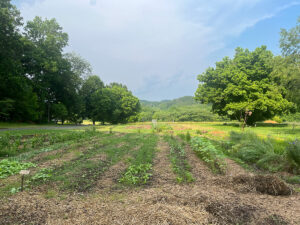
And another thing I’ll say here is that as someone living in a rural community, I have witnessed firsthand how our bonds of community have broken down and have watched traditional ways being lost across the course of my life. Even in my own lifetime, many of the people who held knowledge of how to live more sustainably with the land were lost—my great aunties and uncles, my great grandparents and grandparents knew so much that they did not pass on. What replaces them is more monotony of the larger, destructive culture. I feel like this has gone into overdrive in the last 10 years with the rise of white nationalism and a shift in the US political scene, and it has broken these communities down in very bad ways. For example, I used to love living in a rural farm setting and enjoyed the lifestyle we had here with good food, good community events, and connections. But now, frankly, I fear my neighbors. Since the rise of this red wave of white nationalism, many places in the Appalachians are filled more with gunshots than with song. The Folk School model and the communities that support that model are showing a different way and offering possibilities for what is possible.
I also offer all of this with a caveat: I realize that much of the cultural traditions of Appalachia were built on the foundations of colonialism and require deep interrogation. I’ve interrogated those foundations in depth here, here, and here among other posts–but in this post, I’m going to focus on some of the traditional folkways that are positive aspects of that culture.
Strengthening Local Communities through Song, Dance, and Songcatching

For a week, over 100 participants gathered to learn traditional folk practices, arts, and crafts while being immersed in other aspects of Appalachian folk culture: singing, gardening in sustainable ways, dancing as a community, and breaking bread with each other. I wasn’t sure what to expect from my week at the Folk School, and my experience exceeded my expectations. The Folk School carefully worked to weave in not only dedicated time to learning with a range of levels (my class was an intermediate to advanced class with prior experience required, for example) but also in immersing visitors in a rich folk tradition.
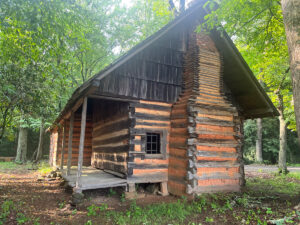
Most mornings, we began the day with Morning Song, which is exactly as it sounds like: starting the day (7:45 am – 8:15 am when breakfast is served) with some kind of music. These may be sing-alongs or performances by local musicians, and all were wonderful. Here’s an example of a recent Morning Song performance (you can find many more on the JCFS Youtube page). I can’t describe the joy that I found in starting the day this way: sitting and listening to a short concert, allowing the music of Appalachia to sink into my bones and put a swing in my step. The music continued, with several evening events either at the Folk School or down the road at the local Crown restaurant with music, dancing, and a wide range of live bluegrass music.
I didn’t realize how much my own region had lost these musical traditions until I was once again immersed in it–every day, we had some opportunity to experience live music with real musicians playing traditional tunes and instruments, sometimes, multiple points in a day. At the Crown on Thursday night, a local music circle was present–about 15 musicians with a range of instruments, the youngest looking to be about 7 and the oldest well into retirement came to play as the sun set over the Smokies. It was beautiful, magical, and connected to the community surrounding the folk school. The community features many other such displays such as their inspiring May Day parade. I could definitely hear the hills singing in joy at all of the beautiful music. These examples show how its not just the presence of this folk school that support these traditional lifeways but the community at large.
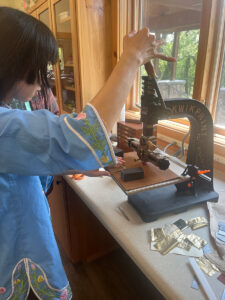
One thing discussed quite a bit at the Folk School among performers and audiences was the idea of “songcatching.” Songcatchers are people who go around into the hills and learn songs from local people. As we druids know, Songcatching can also happen with the land itself–you can go into the hills and be inspired by song or any other bardic creation. Many of the bluegrass performers not only shared their songs but also how they caught them, or how they learned them from someone who caught them. This was a beautiful chain of music that was passed down, preserved, and honored in locally-centered and meaningful ways.
Another opportunity I experienced for the first time was the contra dance or line dance. A group of about 10 musicians came with heir basses and fiddles, and a bunch of us went dancing, with students at the folk school joining the locals and folk school staff for a large, open-air dance. A “caller” came and taught us the dances and then we danced. I’ve never experienced anything like it, and it was a ton of fun. Even my dyslexic-brained self, who can’t tell my left from my right ever, enjoyed lining up, finding a partner, and dancing to the beat of the music, spinning, twirling, and laughing at our mistakes. One of the takeaways I had from this was the important bonds that this experience formed: it is hard to be mad at your neighbor when you are singing, dancing, moving, and laughing joined at the palms. I can see why dances like these were such important aspects of traditional cultures–they strengthen the bonds of community. I danced with so many people that night, and in the days following, we would smile and laugh when we talked about it. I wish we’d have such a culture here–maybe then people would put down their guns and take up a dance or a fiddle. ie
What would these simple music and dance practices do everywhere? Could we bring music back to many places like my own community? I delight in the thought of people coming together in these meaningful ways once again.
Building Deep Commitment to Craft and Collaboration

The Folk School fosters a joyful, non-competitive approach to preserving, teaching, and deepening a range of traditional craft and folk disciplines. As I’ve written about in other posts on this blog, exploring deep aspects of craft allows us to connect with the flow of Awen but also to learn how to be better human beings: by persisting in a serious craft and dedicating ourselves to that craft over a period of time, we learn how to learn, how to deal with struggles and adversity, learn ourselves in a deeper way, learning meaningful self-expression, and learn that hard work pays off. During the week I was there, they were offering a wide range of classes: a class on threaded balls, advanced pottery, advanced wood turning, stained glass, acrylic landscape painting, foraging cooking with wild foods, gardening and herbal arts, full case leather bookbinding (my class), blacksmithing (knife making and Damascus steel), linen cord basketry, and others.

I had the honor of studying Full Case Leather Bookbinding with Jon Buller, who was a master craftsperson focusing on both edition binding and conservation leather bookbinding with over 40 years of experience in the craft of traditional bookbinding. Jon carefully took our class of five through each of the steps to remove old covers of a book, do repairs, build new covers and prepare the book block, prepare the leather (including the intensive paring by hand technique), fully “case” the book in leather, and then apply a range of decorative embellishments, inlays and onlays. We also learned how to build a box for the book with a pared leather edge. This was a very time-intensive class, and beyond our scheduled six hours a day, many of us spent our evenings honing our craft and working on extra books to practice. I was impressed with the in-depth nature of the techniques we were able to practice as well as the community and collaboration we had among the five students in the class.
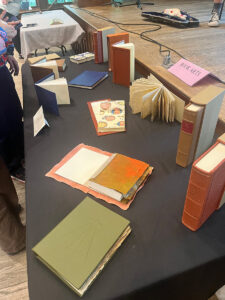
In talking with people in other classes at meals and other social events, it became clear that this attention to in-depth learning, collaborative learning, and non-competitiveness was central to all the classes. Some classes were more designed for the beginner while others were obviously for advanced and skilled practitioners working to further hone their technique. The Folk School had a range of incredibly well-stocked and beautiful studios with equipment–in the “Book and Paper Arts Studio” we had huge personal workspaces, a range of wonderful equipment I would normally not have access to (board cutters, guillotines, book presses, extra paper, weights, and so forth) and a very comfortable environment to work. Everything was set up to maximize our ability to learn and dedicated time to our honoring craft.
This was a transformative experience. It honestly allowed me to get deeper into the “craft” of bookbinding than I’ve ever been able to before and allowed me to substantially build my skills in a supportive yet rigorous environment with a group of dedicated students and instructors. These community-supported ways of reskilling and honing craft were central to our development not only as highly skilled craftspeople but as people in general. And as I can already tell in the two days I’ve been back home, it will have deep and lasting impact on my bardic arts as a whole, particularly in my leatherwork.
As a dyslexic person, sometimes my mind twists and turns in strange ways and certain things are really hard to do. I had a moment covering my box with fabric where I couldn’t wrap my head around the way we were to cut it and kind of broke down, frustrated that my topsy turvey brain couldn’t do what others were doing so easily. Everyone was extremely supportive and it allowed me to take a moment to compose myself and then go right back at it. Thus, while I may have given up by myself, in this supportive community I was able to feel like that neurodiverse brain was supported and in the end, my slightly flawed box still looked wonderful.
The final event of the week was a student showcase, where the whole community came together to celebrate our accomplishments. One of the things I loved about the showcase was that we didn’t just showcase finished work for everyone at the school, but also works in progress and mistakes. On the blacksmithing table was a range of beautiful knives–and also some mistakes and failed attempts. Everyone was embracing their ability to learn and grow from their mistakes and regularize the idea that mistakes are part of learning. Along with the showcase, we had music, community, and song. It was a wonderful way to end the week, and really again affirmed that we humans are better at reskilling and deepening our practices with each other in a supportive environment.

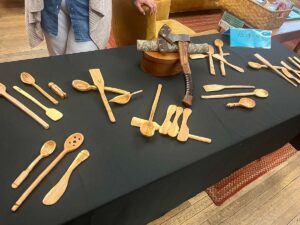


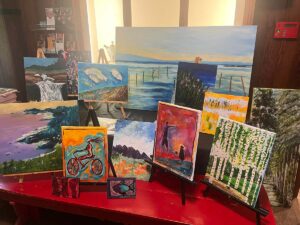
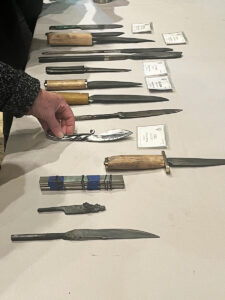
Conclusion

The John C. Campbell Folk School provides an awesome model of how to build a local, craft-focused community that weaves attention to deepening connections of craft and land with song, dance, and local folkways. While I was at the Folk School, I couldn’t keep thinking to myself that we would see a significant transformation in our culture if every community had something just like the Folk School, some center point to bring these rich cultural traditions together in a way that supported and honored the diverse people practicing them. I was so inspired by my week at the Folk School and feel that I not only left with a new skill and new friends but a great model of one method for rebuilding more resilient communities and creating a better future. Because coming together in these powerful ways reminds us that we are stronger together, and building our skills reminds us of the many human gifts that we can offer each other and the land around us.
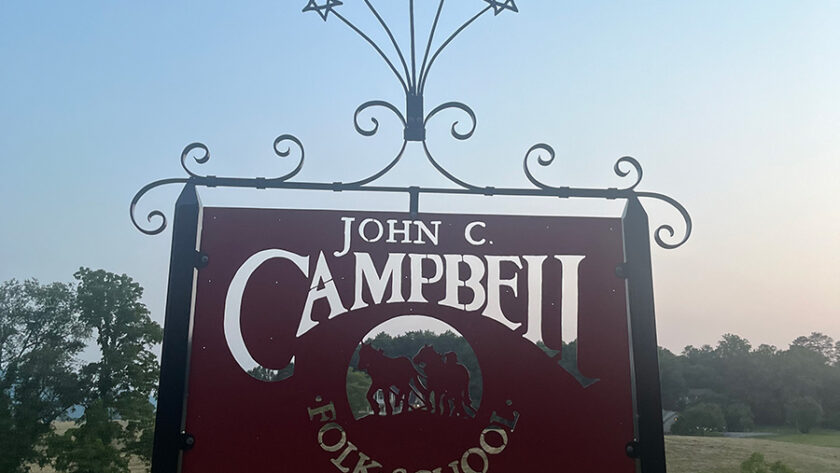

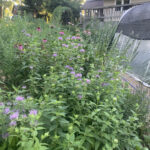
Loved the folk school idea. It really brings back the thought that our western society is missing community. We are also missing music. I have been lucky to have travel experience in South America, and music is everywhere there. It’s so joyful and uplifting. We need more joy in America! Thank you for this article.
Yeah! We totally need more music and joy. I was in the Caribbean back in March and I was thinking the same thing…. 🙂
It’s great that you discovered contradance! Our local dances stopped because of Covid and haven’t come back–yet–although they had one event recently that got good press. I think they migrated here from Ithaca (the source of many good things!).
This folk school is a wonderful thing, but of course most people don’t have the time or money for travel to an expensive, distant school like this. So how do we disseminate, and create, this kind of culture for everyone?
Hi Karen, thanks for reading and commenting. There are about 30 folk schools throughout the US, so it might be that there is one more local that is also more affordable for some people. But one of the other places you can see this kind of folk culture is at various festivals through the spring, summer, and fall. Here in Western PA, we have the Northern Appalacian Folk Festival (here in Indiana, PA), Potato Festival, Strawberry Festivals, Flax festivals, and many more. Some of them didn’t survive covid, but it seems this year there are actually a lot happening. So that would be one suggestion–find people and community, and then work to build some more! We all need each other.
That was a fantastic email newsletter about the folk school. I really enjoyed reading about your experiences and your ideas on how much potential there was for community connection and possibly reconciliation, if regular community events like those described could be brought back, en masse. I agree. Thank you for this inspirational look into your week.
Hi Jodie, I have hope too! It was really exciting to experience and see. I hope that others are inspired to bring some of this (back) to their local communities! 🙂